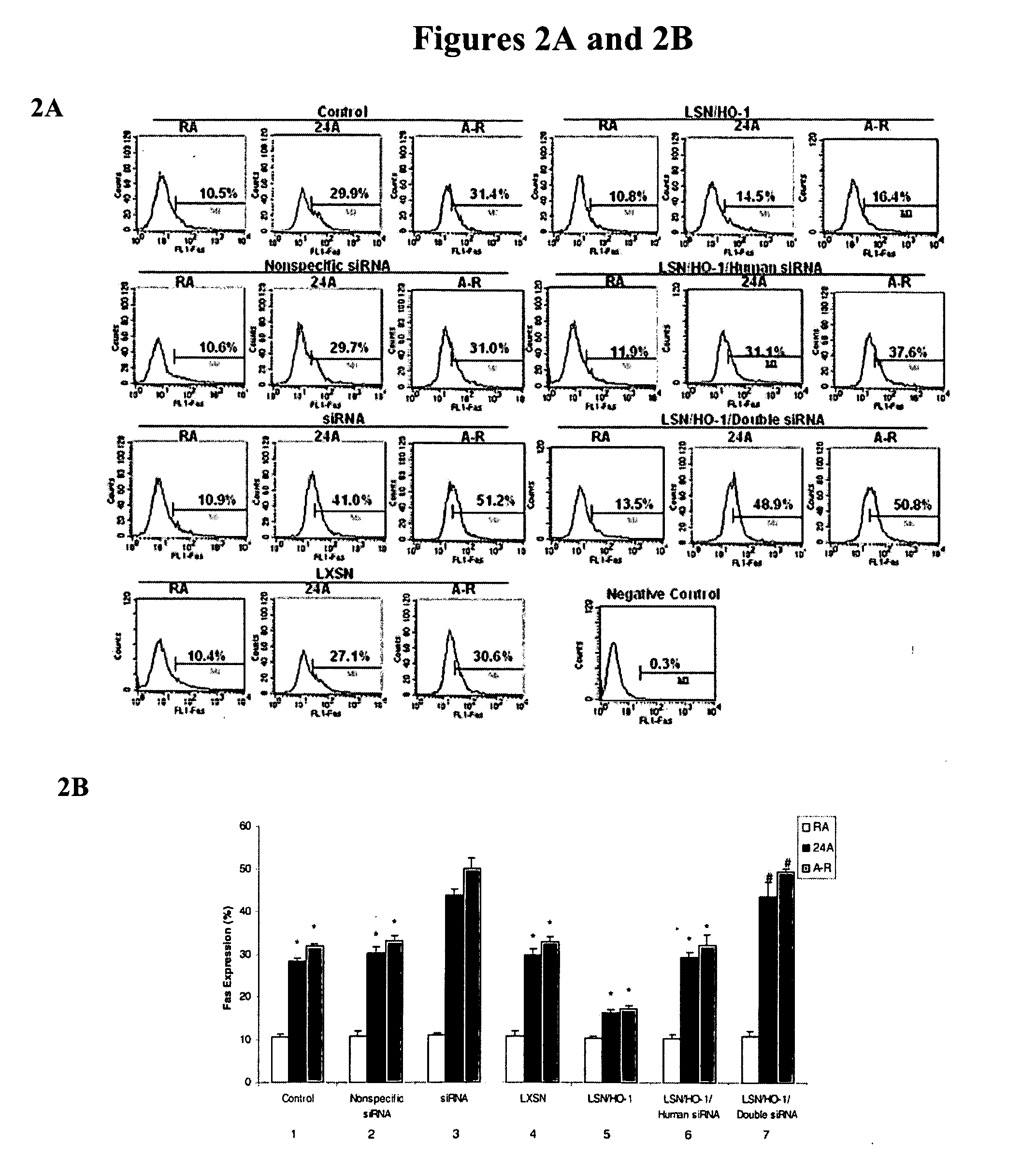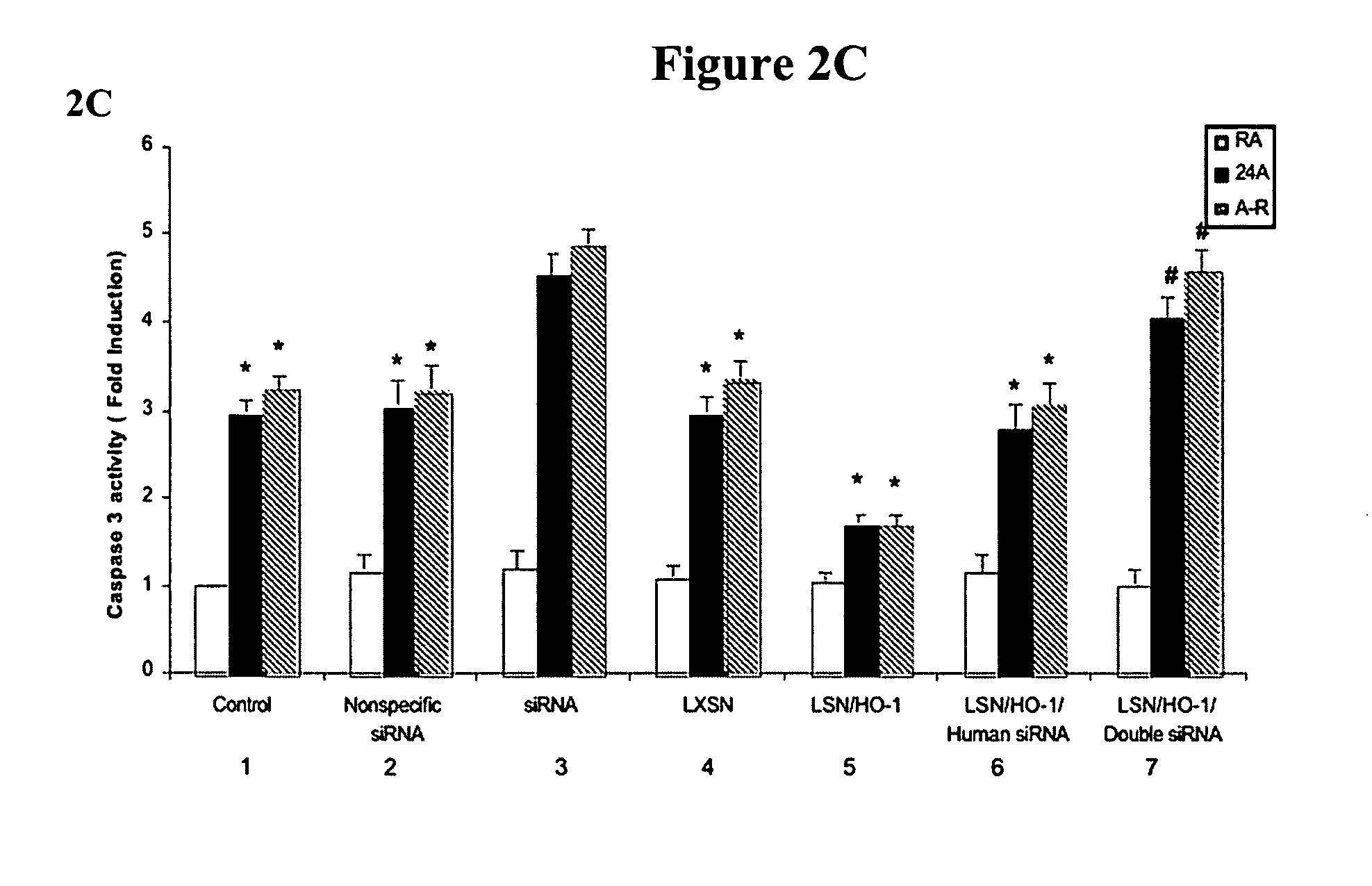Intranasal delivery of nucleic acid molecules
a nucleic acid and intranasal technology, applied in the field of intranasal delivery of nucleic acid molecules, can solve the problems of transgenes producing toxic substances, unattractive use of common systemic delivery methods, and difficult treatment of potential therapeutics with systemic administration, so as to inhibit the expression of heme-oxygenase-1 (ho-1) in the lung, and inhibit gene expression
- Summary
- Abstract
- Description
- Claims
- Application Information
AI Technical Summary
Benefits of technology
Problems solved by technology
Method used
Image
Examples
example 1
Intranasal Administration of Small Interfering RNA Targeting Heme Oxygenase-1 Following Ischemia-Reperfusion (I-R); Comparison with Viral Vector Mediated Delivery
[0069] Intranasal siRNA delivery, without a vector or transfection agent, has lung specificity and heme oxygenase-1 (HO-1) potently regulates lung apoptosis. Systemic HO-1 siRNA may become the basis of modulating severe hyperbilirubinemia of newborns and the severe jaundice of Crigler-Najjar type I patients where there is excessive bilirubin formation and for whom specific therapy does not currently exist.
[0070] HO-1 is one of three isoforms of heme oxygenase (HO), the rate-limiting enzyme in the degradation of heme to biliverdin and eventually to bilirubin. HO-1 expression is induced in multiple cell types and organs in response to injury. This induction is postulated to have protective properties; however, the mechanisms remain elusive. HO-2 is primarily constitutive and has been found to be important in the central ner...
example 2
Intranasal Administration of Small Interfering RNA Targeting Heme Oxygenase-1 Following Hyperoxia
[0096] i. Materials and Methods
[0097] Cell culture and hyperoxia exposures. Murine lung microvascular endothelial cells (MLEC) were isolated from mice lungs with a modification of the methods described by Kuhlencordt et al. 46 and were maintained in 50% DMEM and 50% F12 tissue culture medium supplemented with 20% FBS. Cells were cultured at 37° C. in a humidified atmosphere containing 5% CO2. Hyperoxic conditions were achieved by placing confluent cells in 95% O2 / 5% CO2 at 37° C. in a tightly sealed modular chamber (Billup-Rothberg, Del Mar, Calif.) for up to 72 h. All experiments were conducted in confluent, quiescent cells that form a monolayer in order to avoid cell density variability between control cells and those exposed to hyperoxia during the course of the experiment.
[0098] Animals and hyperoxia exposures. Adult 6 to 8 week old C57BL / 6J mice were obtained from Jackson Laborat...
example 3
Intranasal Administration of Small Interfering RNA Targeting Signal Transducer and Activator of Transcription 3 (STAT3) Following Ischemia-Reperfusion (I-R)
[0106] Signal Transducers and Activators of Transcription (STATs) are transcription factors that are phosphorylated by JAK kinases in response to cytokine activation of a cell surface receptor tyrosine kinases. Upon activation, the STATs dimerize and are localized to the nucleus where they activate transcription of cytokine-responsive genes. Cytokines that activate STAT3 include growth hormone, interleukin-6 (IL-6) family cytokines, and G-CSF. STAT3 induces progression through the cell cycle, prevents apoptosis and upregulates oncogenes. Activated STATs have been observed in a wide variety of human cancers, including lymphomas and solid tumors. In addition, STAT3 has been shown to play a critical role in hematopoiesis. The importance of STAT3 is underscored by the failure of mice lacking STAT3 to survive embryogenesis. The abili...
PUM
| Property | Measurement | Unit |
|---|---|---|
| Body weight | aaaaa | aaaaa |
| Length | aaaaa | aaaaa |
Abstract
Description
Claims
Application Information
 Login to View More
Login to View More - R&D
- Intellectual Property
- Life Sciences
- Materials
- Tech Scout
- Unparalleled Data Quality
- Higher Quality Content
- 60% Fewer Hallucinations
Browse by: Latest US Patents, China's latest patents, Technical Efficacy Thesaurus, Application Domain, Technology Topic, Popular Technical Reports.
© 2025 PatSnap. All rights reserved.Legal|Privacy policy|Modern Slavery Act Transparency Statement|Sitemap|About US| Contact US: help@patsnap.com



